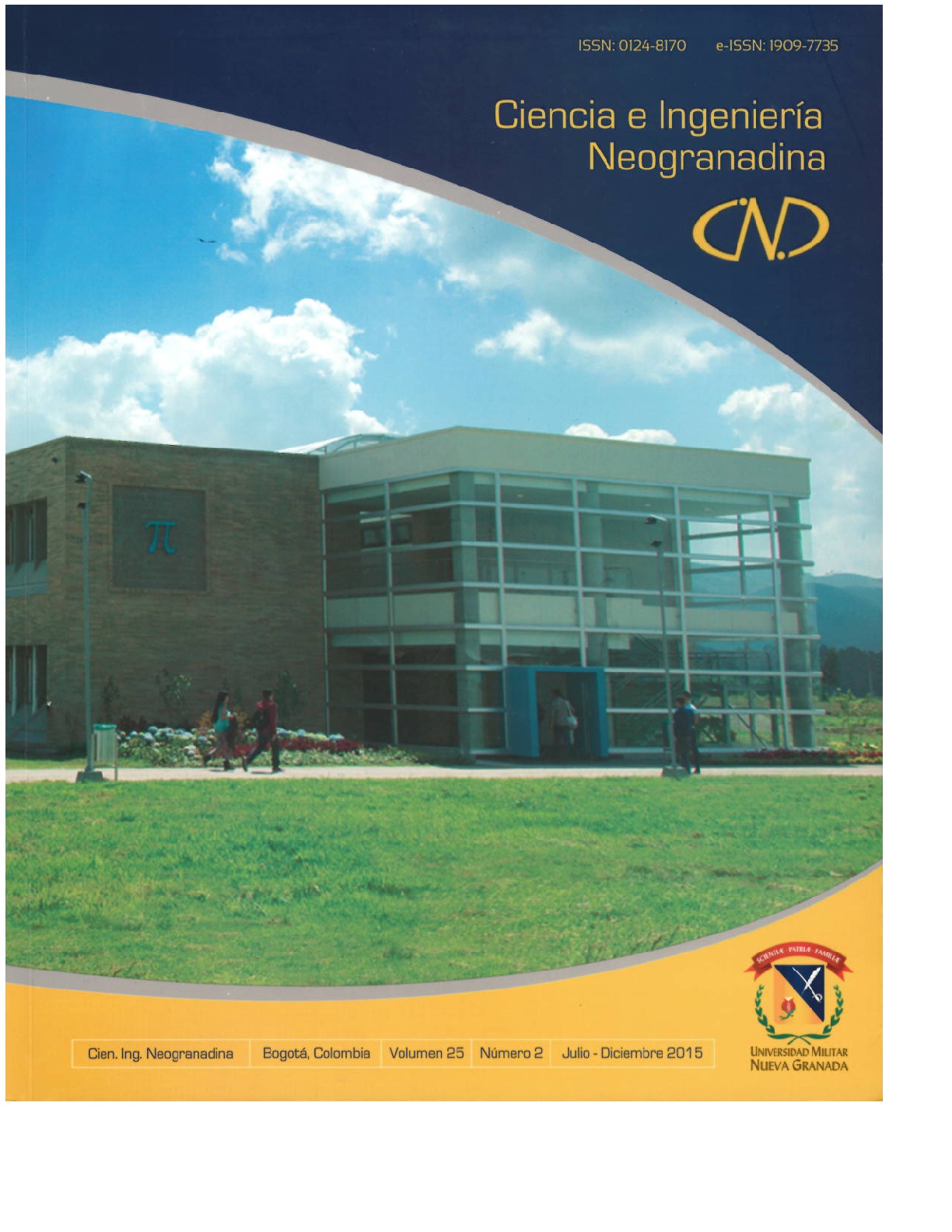Rainfall thresholds for the initiation of landslides. A critical review
Abstract
Multiple rainfall-landslides relationships have been proposed for early warning systems in the world. This work presents a data base that synthesizes the state of the art of rainfall thresholds that generate mass movements in the entire world. The more common rainfall-landslides relationships are processed in order to analyze data in function of the Köppen climatic classification and the area for which it was proposed. The results show a wide range of parameters derived from rainfall that triggers landslides together with considerable differences between threshold values. Data analysis shows the necessity to obtain parameters and thresholds derived from the rainfall that generate landslides for each specific geographical and climatic zone. For that reason, it is possible to generate a rational background that allows us to establish early warning systems of landslides caused by rainfall with low variability. This work provides insights into the catalog of possible parameters derived from rainfall records that allow us to generate thresholds to predict the landslides occurrence. Researchers will have the possibility to search for rainfall-landslide relationships based on statistical analysis, with a wide spectrum of parameters, beyond the traditional variables of antecedent rainfall and the intensity occurred the day of the landslide.
Downloads
Languages:
esSupport agencies:
Pontificia Universidad JaverianaReferences
Wieczorek, G. F. (1996). Landslide triggering mechanisms. Landslides: Investigation and Mitigation, pp. 76-90.
Iverson, R. M. (2000). Landslide triggering by rain infiltration. Water Resources Research, 36(7):1897-1910.
Guzzetti, F., Peruccacci, S., Rossi, M. and Stark, C. P. (2007). Rainfall thresholds for the initiation of landslides in central and southern Europe. Meteorology and Atmospheric Physics, 98(3-4):239-267. DOI: 10.1007/s00703-007-0262-7.
Chivatá Cárdenas, I. (2008). Using multinomial and imprecise probability for non-parametric modelling of rainfall in Manizales (Colombia). Ingeniería e Investigación, 28(2):22-29.
Gabet, E. J., Burbank, D. W., Putkonen, J. K., Pratt-Sitaula, B. A. and Ojha, T. (2004). Rainfall thresholds for landsliding in the Himalayas of Nepal. Geomorphology, 63(3):131-143. DOI: 10.1016/j.geomorph.2004.03.011.
Glade, T. (1998). Establishing the frequency and magnitude of landslide-triggering rainstorm events in New Zealand. Environmental Geology, 35(2-3):160-174. DOI: 10.1007/s002540050302.
Mateos, R. M., García-Moreno, I. and Azañón, J. M. (2012). Freeze–thaw cycles and rainfall as triggering factors of mass movements in a warm Mediterranean region: the case of the Tramuntana Range (Majorca, Spain). Landslides, 9(3):417-432. DOI: 10.1007/s10346-011-0290-8.
Pasuto, A. and Silvano, S. (1998). Rainfall as a trigger of shallow mass movements. A case study in the Dolomites, Italy. Environmental Geology, 35(2-3):184-189. DOI: 10.1007/s002540050304.
Terlien, M. T. J. (1996). Modelling Spatial and Temporal Variations in Rainfall-triggered Landslides: The Integration of Hydrologic Models, Slope Stability Models and Geographic Information Systems for the Hazard Zonation of Rainfall-triggered Landslides with Examples from Manizales (Colombia). International Institute for Aerial Survey and Earth Sciences (ITC).
Caine, N. (1980). The rainfall intensity: duration control of shallow landslides and debris flows. Geografiska Annaler. Series A. Physical Geography, pp. 23-27. DOI: 10.2307/520449.
Glade, T., Crozier, M. and Smith, P. (2000). Applying probability determination to refine landslide-triggering rainfall thresholds using an empirical “antecedent daily rainfall model”. Pure and Applied Geophysics, 157(6-8):1059-1079. DOI: 10.1007/s000240050017.
Jakob, M. and Weatherly, H. (2003). A hydroclimatic threshold for landslide initiation on the North Shore Mountains of Vancouver, British Columbia. Geomorphology, 54(3):137-156. DOI: 10.1016/S0169-555X(02)00339-2.
Aleotti, P. (2004). A warning system for rainfall-induced shallow failures. Engineering Geology, 73(3):247-265. DOI: 10.1016/j.enggeo.2004.01.007.
Guzzetti, F., Peruccacci, S., Rossi, M. and Stark, C. P. (2008). The rainfall intensity –duration control of shallow landslides and debris flows: an update. Landslides, 5(1):3-17. DOI: 10.1007/s10346-007-0112-1.
Brunetti, M., Peruccacci, S., Rossi, M., Luciani, S., Valigi, D. and Guzzetti, F. (2010). Rainfall thresholds for the possible occurrence of landslides in Italy. Natural Hazards and Earth System Science, 10(3):447-458.
Li, C., Ma, T., Zhu, X. and Li, W. (2011). The power–law relationship between landslide occurrence and rainfall level. Geomorphology, 130(3):221-229. DOI: 10.1016/j.geomorph.2011.03.018.
Mathew, J., Babu, D. G., Kundu, S., Kumar, K. V. and Pant, C. (2013). Integrating intensity–duration-based rainfall threshold and antecedent rainfall-based probability estimate towards generating early warning for rainfall-induced landslides in parts of the Garhwal Himalaya, India. Landslides, pp. 1-14. DOI: 10.1007/s10346-013-0408-2.
Peel, M. C., Finlayson, B. L. and McMahon, T. A. (2007). Updated world map of the Köppen-Geiger climate classification. Hydrology & Earth System Sciences Discussions, 4(2). DOI: 10.5194/hess-11-1633-2007, 2007.
Arango Gartner, J. D. et al. (2000). Relaciones lluvias–deslizamientos y zonificación geotécnica en la comuna dos de la ciudad de Manizales. Tesis de Maestría, Universidad Nacional de Colombia, sede Manizales.
Bell, F. and Maud, R. (2000). Landslides associated with the colluvial soils overlying the Natal Group in the greater Durban region of Natal, South Africa. Environmental Geology, 39(9):1029-1038. DOI: 10.1007/s002549900077.
Govi, M. and Sorzana, P. (1980). Landslide susceptibility as a function of critical rainfall amount in piedmont basin (North-Western Italy). Studia Geomorphologica Carpatho-Balcanica, 14:43-61.
Aristizábal, E., González, T., Montoya, J. D., Vélez, J. I., Martínez, H. and Guerra, A. (2011). Analysis of empirical rainfall thresholds for the prognosis of landslides in the Aburrá Valley, Colombia. Revista EIA, (15):95-111.
Au, S. (1998). Rain-induced slope instability in Hong Kong. Engineering Geology, 51(1):1-36. DOI: 10.1016/S0013-7952(98)00038-6.
Corominas, J. and Moya, J. (1999). Reconstructing recent landslide activity in relation to rainfall in the Llobregat river basin, Eastern Pyrenees, Spain. Geomorphology, 30(1):79-93. DOI: 10.1016/S0169-555X(99)00046-X.
Díaz, E., De Olazagoitia, A. S., Ormaetxea, O. and Ibisate, A. (2012). Análisis de factores de desestabilización de laderas en dos cuencas del ámbito atlántico: Sollube-mape (Bizkaia) y Ramaio (Alava). Cuaternario y Geomorfología, 26(1):171-190.
Echeverri, O. y Valencia, Y. (2004). Análisis de los deslizamientos en la cuenca de la quebrada La Iguaná de la ciudad de Medellín a partir de la integración lluvia-pendiente-formación geológica. Dyna, 71(142):33-45.
Kirschbaum, D., Adler, R., Adler, D., Peters-Lidard, C. and Huffman, G. (2012). Global distribution of extreme precipitation and high-impact landslides in 2010 relative to previous years. Journal of Hydrometeorology, 13(5):1536-1551. DOI: http://dx.doi.org/10.1175/JHM-D-12-02.1.
Moreno, H. A., Vélez, M. V., Montoya, J. D. and Rhenals, R. L. (2006). La lluvia y los deslizamientos de tierra en Antioquia: análisis de su ocurrencia en las escalas interanual, intraanual y diaria. Revista EIA, 5:59-69.
Sengupta, A., Gupta, S. and Anbarasu, K. (2010). Rainfall thresholds for the initiation of landslide at Lanta Khola in north Sikkim, India. Natural Hazards, 52(1):31-42. DOI: 10.1007/s11069-009-9352-9.
Cannon, S. H., Boldt, E. M., Laber, J. L., Kean, J. W. and Staley, D. M. (2011). Rainfall intensity–duration thresholds for postfire debris-flow emergency-response planning. Natural Hazards, 59(1):209-236. DOI: 10.1007/s11069-011-9747-2.
Lee, M. L., Ng, K. Y., Huang, Y. F. and Li, W. C. (2014). Rainfall-induced landslides in Hulu Kelang area, Malaysia. Natural Hazards, 70:1-23. DOI 10.1007/s11069-013-0814-8.
Crozier, M. and Eyles, R. (1980). Assessing the probability of rapid mass movement. In Third Australia-New Zealand conference on Geomechanics: Wellington, May 12-16, 1980, p. 2. Institution of Professional Engineers New Zealand.
Jaiswal, P. and van Westen, C. J. (2009). Estimating temporal probability for landslide initiation along transportation routes based on rainfall thresholds. Geomorphology, 112(1):96-105. DOI: 10.1016/j.geomorph.2009.05.008.
Giannecchini, R. (2005). Rainfall triggering soil slips in the southern Apuan Alps (Tuscany, Italy). Advances in Geosciences, 2:21-24. DOI: 10.5194/nhess-12-829-2012.
Annunziati, A., Focardi, A., Focardi, P., Martello, S. and Vannocci, P. (2000). Analysis of the rainfall thresholds that induced debris flows in the area of Apuan Alps-Tuscany, Italy (19 June 1996 storm). In Proc. EGS Plinius Conf. on Mediterranean Storms, Maratea, Italy, pp. 485-493.
Kanji, M., Massad, F. and Cruz, P. (2003). Debris flows in areas of residual soils: occurrence and characteristics. In International Workshop on Occurrence and Mechanism of Flows in Natural Slopes and Earthfills, pp. 1-13.
Guidicini, G. and Iwasa, O. (1977). Tentative correlation between rainfall and landslides in a humid tropical environment. Bulletin of the International Association of Engineering Geology-Bulletin de l’Association Internationale de Géologie de l’Ingénieur, 16(1):13-20. DOI: 10.1007/BF02591434.
Zhou, W. and Tang, C. (2013). Rainfall thresholds for debris flow initiation in the Wenchuan earthquake-stricken area, southwestern China. Landslides, pp. 1-11. DOI: 10.1007/s10346-013-0421-5.
Bacchini, M., Zannoni, A. et al. (2003). Relations between rainfall and triggering of debris-flow: case study of Cancia (Dolomites, Northeastern Italy). Natural Hazards and Earth System Science, 3(1/2):71-79.
Akcali, E., Arman, H., Firat, S., Saltabas, L. and Gunduz, Z. (2010). Rainfall threshold for the initiation of landslides in Trabzon province of Turkey. International Journal of Engineering and Applied Science (IJEAC), 2(4):14-26.
Ahmad, R. (2003). Developing early warning systems in Jamaica: rainfall thresholds for hydrological hazards. National Disaster Management Conference, Ocho Rios. St Ann, Jamaica, pp. 9-10.
Baum, R. L. and Godt, J. W. (2010). Early warning of rainfall-induced shallow landslides and debris flows in the USA. Landslides, 7(3):259-272. DOI: 10.1007/s10346-009-0177-0.
Chien-Yuan, C., Tien-Chien, C., Fan-Chieh, Y., Wen-Hui, Y. and Chun-Chieh, T. (2005). Rainfall duration and debris-flow initiated studies for real-time monitoring. Environmental Geology, 47(5):715-724. DOI: 10.1007/s00254-004-1203-0.
Cannon, S. H. and Gartner, J. E. (2005). Wildfire-related debris flow from a hazards perspective. In Debris-flow Hazards and Related Phenomena, pp. 363-385. Springer.
Cannon, S. H., Gartner, J. E., Wilson, R. C., Bowers, J. C. and Laber, J. L. (2008). Storm rainfall conditions for floods and debris flows from recently burned areas in southwestern Colorado and southern California. Geomorphology, 96(3):250-269. DOI: 10.1016/j.geomorph.2007.03.019.
Coe, J. A., Kinner, D. A. and Godt, J. W. (2008). Initiation conditions for debris flows generated by runoff at Chalk Cliffs, central Colorado. Geomorphology, 96(3):270-297. DOI: 10.1016/j.geomorph.2007.03.017.
Dahal, R. K. and Hasegawa, S. (2008). Representative rainfall thresholds for landslides in the Nepal Himalaya. Geomorphology, 100(3):429-443. DOI: 10.1016/j.geomorph.2008.01.014.
Giannecchini, R. (2006). Relationship between rainfall and shallow landslides in the southern Apuan Alps (Italy). Natural Hazards and Earth System Science, 6(3):357-364. DOI: 10.5194/nhess-6-357-2006.
Godt, J. W., Baum, R. L. and Chleborad, A. F. (2006). Rainfall characteristics for shallow landsliding in Seattle, Washington, USA. Earth Surface Processes and Landforms, 31(1):97-110. DOI: 10.1002/esp.1237.
Hong, Y., Adler, R., and Huffman, G. (2006). Evaluation of the potential of NASA multi-satellite precipitation analysis in global landslide hazard assessment. Geophysical Research Letters, 33(22):L22402. DOI: 10.1029/2006GL028010.
Hong, Y., Hiura, H., Shino, K., Sassa, K., Suemine, A., Fukuoka, H., and Wang, G. (2005). The influence of intense rainfall on the activity of large-scale crystalline schist landslides in Shikoku Island, Japan. Landslides, 2(2):97–105. DOI: 10.1007/s10346-004-0043-z.
Jan, C.-D. and Chen, C.-L. (2005). Debris flows caused by Typhoon Herb in Taiwan. In Debris-Flow Hazards and Related Phenomena, pp. 539-563. Springer. DOI: 10.1007/3-540-27129-5_21.
Khan, Y. A., Lateh, H., Baten, M. A., and Kamil, A. A. (2012). Critical antecedent rainfall conditions for shallow landslides in Chittagong City of Bangladesh. Environmental Earth Sciences, 67(1):97-106. DOI: 10.1007/s12665-011-1483-0.
Larsen, M. C. and Simon, A. (1993). A rainfall intensity-duration threshold for landslides in a humid-tropical environment, Puerto Rico. Geografiska annaler. Series A. Physical Geography, pp. 13-23.
Marchi, L., Arattano, M., and Deganutti, A. M. (2002). Ten years of debris-flow monitoring in the Moscardo Torrent (Italian Alps). Geomorphology, 46(1):1-17. DOI: 10.1016/S0169-555X(01)00162-3.
Miller, S., Brewer, T., and Harris, N. (2009). Rainfall thresholding and susceptibility assessment of rainfall-induced landslides: application to landslide management in St Thomas, Jamaica. Bulletin of Engineering Geology and the Environment, 68(4):539-550. DOI: 10.1007/s10064-009-0232-z.
Paronuzzi, P., Coccolo, A., and Garlatti, G. (1998). Eventi meteorici critici e debris flows nei bacini Montani del Friuli. La Acqua, Sezione I-Memorie, pp. 39-50.
Rosi, A., Segoni, S., Catani, F., and Casagli, N. (2012). Statistical and environmental analyses for the definition of a regional rainfall threshold system for landslide triggering in Tuscany (Italy). Journal of Geographical Sciences, 22(4):617-629. DOI: 10.1007/s11442-012-0951-0.
Ruiz-Villanueva, V., Bodoque, J., Díez-Herrero, A. and Calvo, C. (2011). Triggering threshold precipitation and soil hydrological characteristics of shallow landslides in granitic landscapes. Geomorphology, 133(3):178-189. DOI: 10.1016/j.geomorph.2011.05.018.
Saito, H., Nakayama, D. and Matsuyama, H. (2010). Relationship between the initiation of a shallow landslide and rainfall intensity-duration thresholds in Japan. Geomorphology, 118(1):167-175. DOI: 10.1016/j.geomorph.2009.12.016.
Tiranti, D. and Rabuffetti, D. (2010). Estimation of rainfall thresholds triggering shallow landslides for an operational warning system implementation. Landslides, 7(4):471-481. DOI: 10.1007/s10346-010-0198-8.
Zezere, J., Trigo, R., Trigo, I. et al. (2005). Shallow and deep landslides induced by rainfall in the Lisbon region (Portugal): assessment of relationships with the North Atlantic Oscillation. Natural Hazards and Earth System Science, 5(3):331-344. DOI: 10.5194/nhess-5-331-2005.
Dai, F. and Lee, C. (2001). Frequency-volume relation and prediction of rainfall-induced landslides. Engineering Geology, 59(3):253-266. DOI: 10.1016/S0013-7952(00)00077-6.
Ni, H., Zheng, W., Li, Z. and Ba, R. (2010). Recent catastrophic debris flows in Luding County, SW China: geological hazards, rainfall analysis and dynamic characteristics. Natural Hazards, 55(2):523-542. DOI: 10.1007/s11069-010-9545-2.
Sepúlveda, S. A. and Padilla, C. (2008). Rain-induced debris and mudflow triggering factors assessment in the Santiago cordilleran foothills, Central Chile. Natural Hazards, 47(2):201-215. DOI: 10.1007/s11069-007-9210-6.
García, H. A., Colonia, J. D. and Corrales, J. J. (2013). Plataforma tecnológica para el monitoreo de amenazas naturales en el oleoducto Ocensa. In UPTC, editor, Memorias del 3er. Seminario internacional de ingeniería sísmica y geotecnia, 1-12, Tunja, Colombia.
| Article metrics | |
|---|---|
| Abstract views | |
| Galley vies | |
| PDF Views | |
| HTML views | |
| Other views | |












